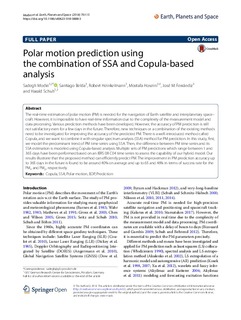| dc.contributor.author | Modiri, Sadegh | |
| dc.contributor.author | Belda, Santiago | |
| dc.contributor.author | Heinkelmann, Robert | |
| dc.contributor.author | Hoseini, Mostafa | |
| dc.contributor.author | Ferrandiz, Jose M | |
| dc.contributor.author | Schuh, Harald | |
| dc.date.accessioned | 2019-09-19T07:33:43Z | |
| dc.date.available | 2019-09-19T07:33:43Z | |
| dc.date.created | 2019-01-29T17:13:22Z | |
| dc.date.issued | 2018 | |
| dc.identifier.citation | Earth Planets and Space. 2018, 70 (1) | nb_NO |
| dc.identifier.issn | 1343-8832 | |
| dc.identifier.uri | http://hdl.handle.net/11250/2617534 | |
| dc.description.abstract | The real-time estimation of polar motion (PM) is needed for the navigation of Earth satellite and interplanetary spacecraft. However, it is impossible to have real-time information due to the complexity of the measurement model and data processing. Various prediction methods have been developed. However, the accuracy of PM prediction is still not satisfactory even for a few days in the future. Therefore, new techniques or a combination of the existing methods need to be investigated for improving the accuracy of the predicted PM. There is a well-introduced method called Copula, and we want to combine it with singular spectrum analysis (SSA) method for PM prediction. In this study, first, we model the predominant trend of PM time series using SSA. Then, the difference between PM time series and its SSA estimation is modeled using Copula-based analysis. Multiple sets of PM predictions which range between 1 and 365 days have been performed based on an IERS 08 C04 time series to assess the capability of our hybrid model. Our results illustrate that the proposed method can efficiently predict PM. The improvement in PM prediction accuracy up to 365 days in the future is found to be around 40% on average and up to 65 and 46% in terms of success rate for the PMx and PMy, respectively. | nb_NO |
| dc.language.iso | eng | nb_NO |
| dc.publisher | Springer | nb_NO |
| dc.rights | Navngivelse 4.0 Internasjonal | * |
| dc.rights.uri | http://creativecommons.org/licenses/by/4.0/deed.no | * |
| dc.title | Polar motion prediction using the combination of SSA and Copula-based analysis | nb_NO |
| dc.type | Journal article | nb_NO |
| dc.type | Peer reviewed | nb_NO |
| dc.description.version | publishedVersion | nb_NO |
| dc.source.volume | 70 | nb_NO |
| dc.source.journal | Earth Planets and Space | nb_NO |
| dc.source.issue | 1 | nb_NO |
| dc.identifier.doi | 10.1186/s40623-018-0888-3 | |
| dc.identifier.cristin | 1667939 | |
| dc.description.localcode | Open Access This article is distributed under the terms of the Creative Commons Attribution 4.0 International License (http://creativecommons.org/licenses/by/4.0/), which permits unrestricted use, distribution, and reproduction in any medium, provided you give appropriate credit to the original author(s) and the source, provide a link to the Creative Commons license, and indicate if changes were made. | nb_NO |
| cristin.unitcode | 194,64,91,0 | |
| cristin.unitname | Institutt for bygg- og miljøteknikk | |
| cristin.ispublished | true | |
| cristin.fulltext | original | |
| cristin.qualitycode | 1 | |

